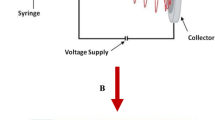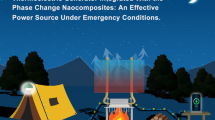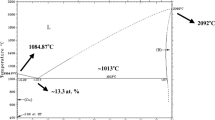Abstract
Ultra-high temperature ceramics (UHTCs) are considered as promising thermal insulation materials applied in ultra-high temperature environments (> 2000 °C). However, the high thermal conductivity and high density limit their further development and application. Herein we adopt the strategies of introducing porous structure and high-entropy effect to solve the above problems. Thus porous high-entropy (Zr0.25Hf0.25Nb0.25Ti0.25)C ceramics were prepared. In order to obtain the uniform pore structure and high mechanical property, the camphene-based freeze-casting method was used in this study. The as-prepared porous samples exhibit high porosity of 92.01–73.57% and homogeneously interconnected pore structure with average pore size of 40.8–19.6 μm. Besides, this work realizes the aims of lightweight (0.65–2.15 g/cm3) and low thermal conductivity (0.29–1.53 W/(m·K)). More importantly, porous samples still have the merit of high compressive strength (0.38–29.02 MPa) due to the even microstructure. The results show that highly porous high-entropy (Zr0.25Hf0.25Nb0.25Ti0.25)C with good overall properties can be an excellent candidate material for ultra-high temperature thermal insulation.





Similar content being viewed by others
References
Fahrenholtz WG, Hilmas GE (2017) Ultra-high temperature ceramics: materials for extreme environments. Scr Mater 129:94–99. https://doi.org/10.1016/j.scriptamat.2016.10.018
Paul A, Jayaseelan DD, Venugopal S, Zapata-Solvas E, Binner J, Vaidhyanathan B, Heaton A, Brown P, Lee WE (2012) UHTC composites for hypersonic applications. Am Ceram Soc Bull 91:22–28. https://doi.org/10.1002/9781118700853.ch7
Padture NP (2016) Advanced structural ceramics in aerospace propulsion. Nat Mater 15:804–809. https://doi.org/10.1038/nmat4687
Yan XL, Constantin L, Lu YF, Silvain JF, Nastasi M, Cui B (2018) (Hf0.2Zr0.2Ta0.2Nb0.2Ti0.2)C high-entropy ceramics with low thermal conductivity. J Am Ceram Soc 101:4486–4491. https://doi.org/10.1111/jace.15779
Meng H, Yu RW, Tang ZY, Wen ZH, Chu YH (2023) Formation ability descriptors for high-entropy carbides established through high-throughput methods and machine learning. Cell Rep Phys Sci 4:101512. https://doi.org/10.1016/j.xcrp.2023.101512
Liu DB, Shi BL, Geng LY, Wang YG, Xu BS, Chen YF (2022) High-entropy rare-earth zirconate ceramics with low thermal conductivity for advanced thermal-barrier coatings. J Adv Ceram 11:961–973. https://doi.org/10.1007/s40145-022-0589-z
Rost CM, Sachet E, Borman T, Moballegh A, Dickey EC, Hou D, Jones JL, Curtarolo S, Maria JP (2015) Entropy-stabilized oxides. Nat Commun 6:8485. https://doi.org/10.1038/ncomms9485
Xiang HM, Xing Y, Dai FZ, Wang HJ, Su L, Miao L, Zhang GJ, Wang YG, Qi XW, Yao L, Wang HL, Zhao B, Li JQ, Zhou YC (2021) High-entropy ceramics: present status, challenges, and a look forward. J Adv Ceram 10:385–441. https://doi.org/10.1007/s40145-021-0477-y
Ma MD, Sun YA, Wu YJ, Zhao ZS, Ye L, Chu YH (2022) Nanocrystalline high-entropy carbide ceramics with improved mechanical properties. J Am Ceram Soc 105:606–613. https://doi.org/10.1111/jace.18100
Liu XY, Zhang P, Huang MZ, Han Y, Xu N, Li Y, Zhang ZJ, Pan W, Wan CL (2023) Effect of lattice distortion in high-entropy RE2Si2O7 and RE2SiO5 (RE=Ho, Er, Y, Yb, and Sc) on their thermal conductivity: experimental and molecular dynamic simulation study. J Eur Ceram Soc 43:6407–6415. https://doi.org/10.1016/j.jeurceramsoc.2023.06.052
Ye BL, Wen TQ, Nguyen MC, Hao LY, Wang CZ, Chu YH (2019) First-principles study, fabrication and characterization of (Zr0.25Nb0.25Ti0.25V0.25)C high-entropy ceramics. Acta Mater. 170:15–23. https://doi.org/10.1016/j.actamat.2019.03.021
Gong LL, Wang YH, Cheng XD, Zhang RF, Zhang HP (2013) Thermal conductivity of highly porous mullite materials. Int J Heat Mass Transf 67:253–259. https://doi.org/10.1016/j.ijheatmasstransfer.2013.08.008
Chen H, Xiang HM, Dai FZ, Liu JC, Zhou YC (2019) Low thermal conductivity and high porosity ZrC and HfC ceramics prepared by in-situ reduction reaction/partial sintering method for ultrahigh temperature applications. J Mater Sci Technol 35:2778–2784. https://doi.org/10.1016/j.jmst.2019.05.044
Chen Y, Wang NN, Ola O, Xia YD, Zhu YQ (2021) Porous ceramics: light in weight but heavy in energy and environment technologies. Mat Sci Eng R 143:100589. https://doi.org/10.1016/j.mser.2020.100589
Wu Z, Liang XP, Shao ZJ, Chen HK, Li JN, Wang JY (2021) Highly porous multicomponent (Hf1/3Ta1/3Nb1/3)C ultra-high temperature ceramic with low thermal conductivity. Materialia 18:101158. https://doi.org/10.1016/j.mtla.2021.101158
Hammel EC, Ighodaro OLR, Okoli OI (2014) Processing and properties of advanced porous ceramics: an application based review. Ceram Int 40:15351–15370. https://doi.org/10.1016/j.ceramint.2014.06.095
Shao GF, Hanaor DAH, Shen XD, Gurlo A (2020) Freeze casting: from low-dimensional building blocks to aligned porous structures-a review of novel materials, methods, and applications. Adv Mater 32:1907176. https://doi.org/10.1002/adma.201907176
Du JC, Zhang XH, Hong CQ, Han WB (2013) Microstructure and mechanical properties of ZrB2-SiC porous ceramic by camphene-based freeze casting. Ceram Int 39:953–957. https://doi.org/10.1016/j.ceramint.2012.07.012
Deville S (2008) Freeze-casting of porous ceramics: a review of current achievements and issues. Adv Eng Mater 10:155–169. https://doi.org/10.1002/adem.200700270
Silvestroni L, Sciti D (2010) Sintering behavior, microstructure, and mechanical properties: a comparison among pressureless sintered ultra-refractory carbides. Adv Mater Sci Eng 2010:1–11. https://doi.org/10.1155/2010/835018
Castle E, Csanadi T, Grasso S, Dusza J, Reece M (2018) Processing and properties of high-entropy ultra-high temperature carbides. Sci Rep 8:8609. https://doi.org/10.1038/s41598-018-26827-1
Du B, Liu HH, Chu YH (2020) Fabrication and characterization of polymer-derived high-entropy carbide ceramic powders. J Am Ceram Soc 103:4063–4068. https://doi.org/10.1111/jace.17134
Sciti D, Guicciardi S, Nygren M (2008) Spark plasma sintering and mechanical behaviour of ZrC-based composites. Scr Mater 59:638–641. https://doi.org/10.1016/j.scriptamat.2008.05.026
Yang QQ, Wang XQ, Bao WC, Wu P, Wang XF, Guo XJ, Zhang C, Zhang GJ, Jiang DY (2022) Influence of equiatomic Zr/(Ti, Nb) substitution on microstructure and ultra-high strength of (Ti, Zr, Nb)C medium-entropy ceramics at 1900 °C. J Adv Ceram 11:1457–1465. https://doi.org/10.1007/s40145-022-0623-1
Zhang X, Hilmas GE, Fahrenholtz WG, Deason DM (2007) Hot pressing of tantalum carbide with and without sintering additives. J Am Ceram Soc 90:393–401. https://doi.org/10.1111/j.1551-2916.2006.01416.x
Zhao LY, Jia DC, Duan XM, Yang ZH, Zhou Y (2011) Pressureless sintering of ZrC-based ceramics by enhancing powder sinterability. Int J Refract Met Hard Mater 29:516–521. https://doi.org/10.1016/j.ijrmhm.2011.03.001
Ghaffari SA, Faghihi-Sani MA, Golestani-Fard F, Mandal H (2013) Spark plasma sintering of TaC-HfC UHTC via disilicides sintering aids. J Eur Ceram Soc 33:1479–1484. https://doi.org/10.1016/j.jeurceramsoc.2013.01.017
Yu D, Yin J, Zhang BH, Liu XJ, Reece MJ, Liu W, Huang ZR (2021) Pressureless sintering and properties of (Hf0.2Zr0.2Ta0.2Nb0.2Ti0.2)C high-entropy ceramics: the effect of pyrolytic carbon. J Eur Ceram Soc 41:3823–3831. https://doi.org/10.1016/j.jeurceramsoc.2021.01.048
Shao ZJ, Wu Z, Sun LC, Liang XP, Luo ZP, Chen HK, Li JN, Wang JY (2022) High entropy ultra-high temperature ceramic thermal insulator (Zr1/5Hf1/5Nb1/5Ta1/5Ti1/5)C with controlled microstructure and outstanding properties. J Mater Sci Technol 119:190–199. https://doi.org/10.1016/j.jmst.2021.12.030
Qin Y, Liu JX, Liang YC, Zhang GJ (2022) Equiatomic 9-cation high-entropy carbide ceramics of the IVB, VB, and VIB groups and thermodynamic analysis of the sintering process. J Adv Ceram 11:1082–1092. https://doi.org/10.1007/s40145-022-0594-2
Zhang Y, Sun SK, Guo WM, Xu L, Zhang W, Lin HT (2020) Optimal preparation of high-entropy boride-silicon carbide ceramics. J Adv Ceram 10:173–180. https://doi.org/10.1007/s40145-020-0418-1
Luo SC, Guo WM, Zhou YZ, Plucknett K, Lin HT (2021) Textured and toughened high-entropy (Ti0.2Zr0.2Hf0.2Nb0.2Ta0.2)C-SiCw ceramics. J Mater Sci Technol 94:99–103. https://doi.org/10.1016/j.jmst.2021.02.073
Yoon BH, Park CS, Kim HE, Koh YH (2007) In situ synthesis of porous silicon carbide (SiC) ceramics decorated with SiC nanowires. J Am Ceram Soc 90:3759–3766. https://doi.org/10.1111/j.1551-2916.2007.02037.x
Chen H, Xiang HM, Dai FZ, Liu JC, Lei YM, Zhang J, Zhou YC (2019) High porosity and low thermal conductivity high entropy (Zr0.2Hf0.2Ti0.2Nb0.2Ta0.2)C. J Mater Sci Technol 35:1700–1705. https://doi.org/10.1016/j.jmst.2019.04.006
Li F, Kang Z, Huang X, Wang XG, Zhang GJ (2014) Preparation of zirconium carbide foam by direct foaming method. J Eur Ceram Soc 34:3513–3520. https://doi.org/10.1016/j.jeurceramsoc.2014.05.029
Wang SJ, Liu MW, Liu XH, Jia QL, Zhang SW (2022) Carbothermal reduction synthesis of high porosity and low thermal conductivity ZrC-SiC ceramics via an one-step sintering technique. J Eur Ceram Soc 42:4465–4471. https://doi.org/10.1016/j.jeurceramsoc.2022.04.044
Ashby MF (1983) The mechanical properties of cellular solids. Metall Trans A 14:1755–1769. https://doi.org/10.1007/Bf02645546
Lu K, Liu JX, Wei XF, Bao WC, Wu Y, Li F, Xu FF, Zhang GJ (2020) Microstructures and mechanical properties of high-entropy (Ti0.2Zr0.2Hf0.2Nb0.2Ta0.2)C ceramics with the addition of SiC secondary phase. J Eur Ceram Soc 40:1839–1847. https://doi.org/10.1016/j.jeurceramsoc.2019.12.056
Russell HW (1935) Principles of heat flow in porous insulators. J Am Ceram Soc 18:1–5. https://doi.org/10.1111/j.1151-2916.1935.tb19340.x
Yan NN, Fu QG, Zhang YY, Li K, Xie W, Zhang JP, Zhuang L, Shi XH (2020) Preparation of pore-controllable zirconium carbide ceramics with tunable mechanical strength, thermal conductivity and sound absorption coefficient. Ceram Int 46:19609–19616. https://doi.org/10.1016/j.ceramint.2020.05.023
Acknowledgements
This work was supported by the National Natural Science Foundation of China under Grant Nos. U21A2063, 52372071; National Key R&D Program of China under Grant No. 2021YFB3702300; LiaoNing Revitalization Talents Program under Grant No. XLYC2002018; and Natural Science Foundation of Liaoning Province under Grant No. 2022-MS-007. The author thanks Doctor Zhuojie Shao and Master Qiaoqi Zhou for the help of discussion for experimental procedures and some TEM works.
Author information
Authors and Affiliations
Corresponding authors
Ethics declarations
Competing interest
The authors declare that they have no known competing financial interests or personal relationships that could have appeared to influence the work reported in this paper.
Additional information
Handling Editor: Naiqin Zhao.
Publisher's Note
Springer Nature remains neutral with regard to jurisdictional claims in published maps and institutional affiliations.
Rights and permissions
Springer Nature or its licensor (e.g. a society or other partner) holds exclusive rights to this article under a publishing agreement with the author(s) or other rightsholder(s); author self-archiving of the accepted manuscript version of this article is solely governed by the terms of such publishing agreement and applicable law.
About this article
Cite this article
Zeng, D., Zhou, J., Wu, Z. et al. Porous high-entropy (Zr0.25Hf0.25Nb0.25Ti0.25)C with high strength and uniform pore structure fabricated by freeze-casting. J Mater Sci (2024). https://doi.org/10.1007/s10853-024-09456-0
Received:
Accepted:
Published:
DOI: https://doi.org/10.1007/s10853-024-09456-0




